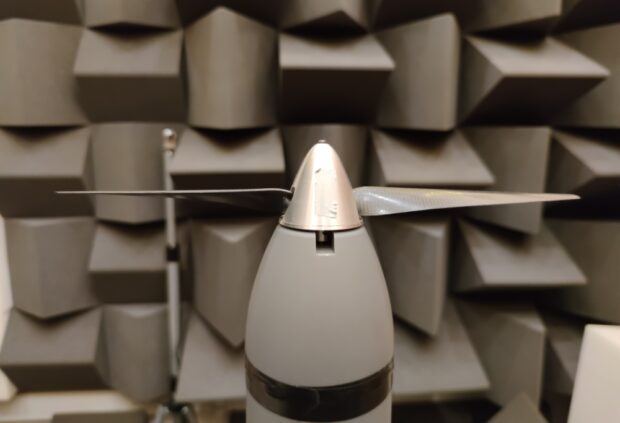The effects of the ground on propeller noise have been measured experimentally for the very first time by researchers in the Aeroacoustics research team at the University of Bristol.
In findings, published in the Journal of Sound and Vibration, the team found clear differences in the noise characteristics of propellers when over ground, known as ‘Ground Effect’, compared to when operated normally. They noted an overall noise increase when measuring at angles above the ground, with hydrodynamic and acoustic interaction effects being a key factor to the overall noise trends.
It is hoped this research, tested in the National Aeroacoustic Wind Tunnel facility, can inform strategies to reduce the noise of aircraft while taking off or landing, by either changing the design of the landing pads or by changing the design of proposed aircraft architectures.
Lead author Liam Hanson explained:
“In light of the need for greener aviation, there has been a push in the aviation industry to develop electrified aircraft. There is a lot of potential benefits from electric aircraft which have been identified by a variety of companies worldwide, including all of the major aircraft manufacturers.”
However, if urban air services such as on demand air taxis are to become a reality within city limits, engineers must tackle the issue of sound pollution, generated by propellers.
An important subset of electric aircraft being developed recently are for the purposes of Advanced Air Mobility (AAM). These aircraft can be broadly considered to fit in three different categories.
The first is Electric Vertical Take-Off and Landing (eVTOL) aircraft which is focussing on Urban Air Mobility (UAM) applications such as air taxis, patient transfers, rooftop-to-rooftop trips within cities and airport transfers.
The second category is Electric Conventional Take-Off and Landing (eCTOL) aircraft which is being developed for Regional Air Mobility (RAM). RAM focusses on cargo deliveries, short-range flights and passenger transfers from rural regions.
The most commonly recognisable electric aircraft, small Unmanned Aircraft Systems (sUAS) or drones, can be considered the third category which focusses on videography, small package delivery and medical supply transfer.
Each of these categories of electric aircraft often uses propellers or rotors to generate thrust to take off and land. Crucially, eVTOL aircraft are operating in urban areas with large populations and as a result the noise generated by the aircraft is critical to understand and reduce if UAM is to be possible.
The propellers used by the aircraft are smaller than helicopters which have been in use for years, usually being far smaller in diameter and rotating at higher speeds. As a result the noise characteristics are very different to the existing knowledge, and so further research is required.
While eVTOL and sUAS aircraft are taking off or landing from a rooftop or landing pad, the propellers are likely to experience Ground Effect, an aerodynamic phenomenon which changes the performance of propellers.
This change in the propeller aerodynamics within Ground Effect changes the acoustic performance of the propellers and causes complex interactions.
Liam said:
“Until now, no literature existed for the problem of isolated propeller noise in ground effect.
“Our research sought to answer for the first time what happens to propeller noise while it operates in Ground Effect and what are the key acoustic and aerodynamic interactions which are most important to understand.
“For the first time we have comprehensively measured the noise of small-scale propellers during take-off and landing while interacting with the ground. It is clear we can expect louder eVTOL aircraft during take-off and landing if the complex interactions with the ground are not considered.”
Based off their new understanding of propeller noise in Ground Effect, they are now conducting additional tests on different methods to potentially reduce the noise of the entire system.
The research was sponsored by Embraer S.A. and the Horizon 2020 SilentProp project (agreement number 882842).
Paper:
‘Experimental investigation of propeller noise in ground effect’ by Liam Hanson et al in Journal of Sound and Vibration.
Photo: Propeller in wind tunnel – Liam Hanson
Source: Press Release

